As we’ve discussed before, dogs often tend to their wounds orally.
This usually involves licking away any debris in the wound lathering it up with spit. But while this is a good adaptation for dealing with minor wounds, it isn’t always something you want to encourage.
Dogs can make some wounds worse by engaging in licking and biting behaviors. They can cause small wounds to become big wounds, and they can quickly snip through sutures with their teeth, which could lead to very serious problems.
Accordingly, it is often necessary to prevent these types of behaviors, so your dog can heal. E-collars – those lamp-shade-looking things you sometimes see dogs wearing — are one of the best tools for putting an end to destructive licking and chewing behaviors.
E-collars are also referred to as cones, recovery collars, or jokingly “cones of shame.”
Dogs often hate wearing them, but this is one of those cases in which you must make them do something they hate for their own good.
Below, we’ll discuss the different types of E-collars, the situations in which they are helpful and review five of the best options available on the market.
Quick Picks: Best E-Collars For Canine Recovery
- Comfy Zone Recovery Collar. [Best Overall] This foldable recovery e-cone is made from foam and nylon, providing a soft, comfy cone for your dog’s healing. Easy to wipe down and available in several sizes.
- KONG EZ Soft E-Collar [Best For Small Dogs] This soft material e-collar from Kong is gentle and comfortable, with a drawstring that allows for easy size adjustments.
- Alfie Pets Noah Recovery Collar [Cutest E-Collar] This soft plush-material e-collar comes in an adorable lion design, keeping your dog adorable why she rests up. Also great for Halloween! (XS-XXL)
What Does the “E” in “E-Collar” Stand For?
The “E” in “E-collar” stands for “Elizabethan collar”, as in the types of collars people in this time period would wear). I bet your dog is feeling fancier already!
Different Types of E-Collars
E-collars are basically designed to get in your dog’s way; they physically prevent your dog from reaching her haunches, back or belly with her mouth. But they accomplish this feat in a few different ways, and there are three basic designs from which you can choose.
Rigid
Rigid E-collars are the oldest design of the three. These are the infamous “lampshade” collars that fit around your dog’s neck and extend in front of her face.
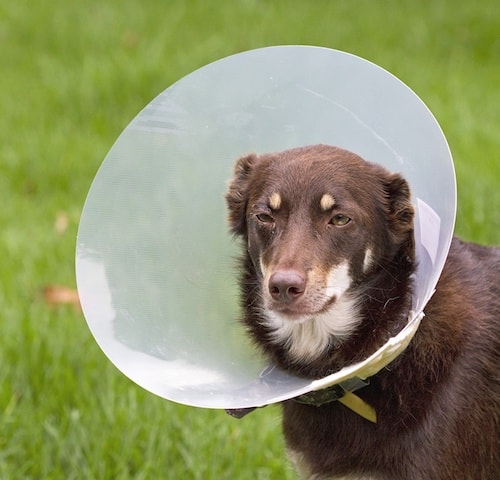
They are typically made from semi-flexible plastic, and they are pretty effective at keeping your dog from chewing and licking on just about any part of her body (although she may still be able to reach portions of her front legs).
The downside to rigid E-collars is that dogs really hate them. They are probably the least comfortable of the three design styles, and they block your dog’s peripheral vision to varying degrees, which can make some dogs nervous. Also, because of the way they extend around your dog’s head, they make it difficult for dogs to get around the house.
Plus, they look utterly ridiculous.
Flexible
Flexible E-collars are generally similar to rigid E-collars, but instead of semi-flexible plastic, they are made of softer and more flexible materials. They are often made from a very thin plastic or cardboard cone, which is covered with padded materials to provide additional comfort.
Flexible E-collars are much more comfortable for dogs to wear, and they won’t create a racket when your dog bumps into door frames and other obstacles in your home. They aren’t quite as effective as rigid cones, as their flexibility allows your dog a little more wiggle room to potentially get her muzzle within licking distance of her booboo.
But, on balance, flexible E-collars often provide a good mix of efficacy and comfort.
Inflatable
Inflatable E-collars look like the neck pillows people use on airplanes or after falling into a pit. They feature an inflatable bladder, which is covered with a durable and comfortable material. A strap of some type is usually included to keep the collar securely around your dog’s neck.
These work in a similar manner to the other types of E-collars – the inflatable bladder simply prevents your dog from being able to move her head back far enough to reach most of her body. However, inflatable E-collars they offer a few key benefits that other styles don’t.
For example, inflatable collars don’t block your dog’s peripheral vision, so it will help keep some dogs calmer while wearing them. And, inflatable-style E-collars are probably the most comfortable of the three basic designs. They’re also quite light and probably impact your dog’s movement the least.
However, inflatable E-collars aren’t quite as effective as rigid or flexible collars, and they may not prevent your dog from accessing wounds in some locations if your pooch is especially determined and flexible.
When Is an E-Collar Necessary?
E-collars are very important tools to use in some cases, but you don’t need to put an E-collar around your dog’s neck every time she gets a minor wound. Most dogs don’t like wearing them, so you’ll want to pick and choose your spots.
Generally, the following four circumstances should cause you to consider fitting your dog with an E-collar:
1. Dogs Recovering from Significant Wounds
If your dog has a large cut – including a surgical incision – you’ll want to fit her with an E-collar to prevent her from licking the wound and prolonging the healing process. In the case of surgeries like spaying or neutering, vets often recommend e-collars.

2. Dogs Suffering from Repetitive Licking Issues
Some dogs develop behavioral problems that trigger them to lick or chew a given area repeatedly. This can lead to a number of health problems, including lick granulomas, so you’ll need to use an E-collar to prevent the behavior while you work on addressing the underlying issue.
3. Allergies and other Skin Issues
E-collars are often helpful for preventing dogs with allergies or skin problems from incessantly licking and scratching their skin. It is still important to address the root cause of the issue, as you don’t want your dog to go mad with itchiness, but an E-collar can help her heal while you and your vet work on fixing the problem.
4. Anytime Your Vet Recommends It
Your vet may recommend using an E-collar to prevent your dog from licking or chewing on parts of her body. Often, the vet’s office will provide you with an E-collar during your visit, but it will usually be of the inexpensive and rigid variety, so you may want to upgrade to a more comfortable version.
The Five Best Dog Cones and E-Collars
The dog E-collar market is surprisingly crowded, which can make it difficult to narrow down your choices. But we’ve detailed five of the best options below.
1. KONG EZ Soft E-Collar for Cats and Dogs
About: The KONG EZ Soft E-Collar is one of the most popular E-collars on the market, and it comes with just about every design feature an owner could want. Like most other KONG products, the EZ E-Collar is well-made, durable, and built to stand up to your dogs pawing and wound-worrying.
- Ideal for injuries, rashes and post surgery
- Constructed from pliable fabric
- Drawstring collar
- Suitable for cats and small dogs, colors may vary.
Features: The KONG EZ Soft E-Collar is a flexible design, which is made to keep your dog from chewing or licking her skin, while not driving her absolutely batty in the process.
Made from a pliable fabric, rather than PVC or cardboard, the collar relies on an internal wire to keep its shape.
The collar material is quite flexible and provides plenty of give to help prevent your dog from knocking things over while walking around with the collar. It also allows dogs to sleep comfortably while wearing the cone.
This collar features a drawstring that allows you to cinch it snuggly against your dog’s neck. This helps to hold it in place and prevent your dog from slipping free.
PROS
The majority of owners who tried the KONG EZ Soft E-Collar were very pleased. Most reported that their dog seemed to remain relatively comfortable while wearing the cone, and some explained that their dog was still able to eat, drink and navigate the home more easily than when wearing a rigid cone.
CONS
A number of owners expressed frustration with the product’s stitching, which seemed to come apart in some cases. A few others had sizing issues, but this is easy to avoid by measuring your dog carefully before making a purchase.
2. Alfie Pet Recovery Collar
About: The Alfie Pet Recovery Collar proves that your pup can remain adorable while she heals. Designed to make your dog look like a ferocious lion, this soft E-collar allows you to show off your dog’s comical side while still preventing her from chewing wounds and flea bites.
No products found.
And, if you don’t like the lion motif, you can make your pup look like a frog or flower instead.
Features: This E-collar is made from soft, flexible plush fabric. It includes a bit of frilly material around the circumference to mimic a lion’s mane and two cute ears to complete the look. For the record, this E-collar would probably make a pretty good costume for your pooch too.
A Velcro closure is used to keep the collar fitting properly, making it easy to put on or remove as needed. The Alfie Pet Recovery Collar is also machine washable, which makes it easy to keep clean and looking great.
PROS
Most owners found the Alfie Pet Recovery Collar to be absolutely adorable. Several owners were also impressed with how easy it was to keep it clean and looking brand new.
CONS
Some owners complained that while cute, the collar didn’t prevent their dog from accessing their wounds. In a few cases, owners reported that the collar would turn inside out easily and required frequent adjustments.
3. Vivifying Pet Cone
About: The Vivifying Pet Cone is a traditional-style E-collar, but it features a number of key upgrades that make it better than the E-collars of years past.
- PROTECT YOU AND YOUR PETS - The cat cone can prevent your pets from biting and licking the wound...
- SUITABLE FOR MOST CATS AND SMALL DOGS - Neck girth 5.7inch- 8inch, width 5.4inch, the Elizabethan...
Features: While the bulk of the Vivifying Pet Cone is comprised of relatively stiff PVC plastic, the neck region and outer rim are both covered with soft flannel material. This will not only keep your pup’s neck more comfortable, it will dull the impact she feels when she bumps into a wall or piece of furniture.
The Vivifying Pet Cone uses three different sets of snaps to remain in place and allow you to tailor the size of the neck opening to fit your dog, so you don’t need to worry too much about measuring for the perfect exact size.
This product is also backed by a lifetime warranty and a 100% satisfaction-guaranteed money-back guarantee.
PROS
Most owners reported that the Vivifying Pet Cone worked well and seemed to fit their dog comfortably. A few were also pleased that the Vivifying Per Cone remained securely attached to their dog, and didn’t allow them to wiggle out of it.
CONS
A few owners found that the cone wasn’t stiff enough and that it allowed their dog to access their wound in some cases. Most folks didn’t have an issue though.
4. Comfy Cone Pet Recovery Collar
About: The Comfy Cone Recovery Collar is veterinarian tested and approved soft e-collar that is designed to keep your dog comfortable while she requires the protection an e-collar provides.
- The Original Comfy Cone: Help your pet heal in comfort with the All Four Paws Original Comfy Cone!...
- Adjustable Sizing: With 3 sizing strips, these dog and cat recovery cones to stop licking have hook...
- High-Quality Dog Cones: Our soft cone for dogs and cats is made with foam-backed padded nylon that...
- Reliable Comfort: With neck loops to thread your pet’s collar through, these soft cones for dogs...
Features: The Comfy Cone is made from foam-backed padded nylon, designed to keep your dog comfortable, even while she’s trying to eat, drink, or sleep.
The cone is reversible, and it features Velcro closures to ensure a snug fit, but you’ll need to thread your dog’s collar through several loops on the cone to keep it in place.
Thin plastic pieces can be inserted or removed from the cone as desired, to alter the rigidity. Reflective binding around the edge of the collar helps to keep your dog visible to passing motorists. It also helps you avoid tripping over your dog when you go to the kitchen for a midnight snack.
The Comfy Cone is water-resistant and easy to clean with a bit of soap and water.
PROS
Most pet parents who tried out the Comfy Cone found that it worked well. It doesn’t seem to have the problems from which other flexible collars suffer, such as turning inside out, and it appears to be quite comfortable for dogs. Many owners also reported that it was very easy to keep the Comfy Cone clean by wiping it with a damp rag.
CONS
A few owners found that the Comfy Cone was heavier than traditional E-collars, so it might be especially difficult for small or light dogs. Also, because the Comfy Cone is opaque, it completely blocks the peripheral vision of dogs.
5. E-KOMG Inflatable Dog Collar
About: The E-KOMG Inflatable Dog Collar features a neck-pillow-style design to deliver the most comfort possible. It stops your dog from reaching her body by preventing her from folding her neck back fully.
No products found.
Features: The E-KOMG Inflatable Dog Collar is comprised of a flexible, air-filled bladder (which you can inflate or deflate as necessary to achieve a good fit), a few loops through which you’ll thread your dog’s collar, and a strap to help keep the collar in place.
The collar is designed to be bite-and-scratch-resistant, so you don’t have to worry about your dog popping the inner bladder. You can remove the collar’s outer cover to wash it when necessary.
PROS
Some dogs seemed to find this collar much more comfortable than traditional cone-style E-collars, and the inflatable nature of the product helps to ensure that it fits well. Additionally, this type of E-collar does not block your dog’s peripheral vision very much.
CONS
Inflatable collars like this one may not work for very flexible dogs. In some cases, it wasn’t effective at preventing dogs from licking or biting their front paws, as the frontal areas of the body are easier for the dogs to access. Additionally, some dogs may still be able to scratch their head or face with their back legs since the collar isn’t quite as movement restrictive as others.
Dog Cone Collar Alternatives: Some Other Options
Cones and E-collars are pretty effective tools that can help protect your dog’s body from his chewing and licking behavior, but they aren’t the only game in town. There are actually a few E-collar alternatives that may work for you and your pet.
Alternative #1: The Bitenot Collar
The Bitenot Collar is a flexible-plastic and foam sleeve that you’ll fit around your dog’s neck. It looks a bit like a human neck brace, but unlike E-collars, which work by getting in your dog’s way, the Bitenot Collar works by restricting the movement of your dog’s head.
The Bitenot Collar isn’t effective for protecting your dog’s face, as he’ll still be able to use his paws to access these areas. It may also allow dogs to access their front legs – particularly the lower portions thereof. However, it will put an end to licking and chewing on the rear portions of the body, and most dogs will probably find it more comfortable (and less humiliating) to wear than an E-cone.
Just be sure to take this collar off your dog periodically, as the plastic material can trap moisture near the skin. This can lead to skin wounds, so give your dog’s neck a breather every so often to let his skin dry (but monitor him while doing so!).
Alternative #2: The Optivisor

The Optivisor is a clear plastic shield that is solely designed to protect your dog’s face. It isn’t a good choice for dogs who bite or chew their skin; instead, it is intended for dogs who are suffering from some type of facial injury. It protects your dog’s face from his paws, rather than protecting his skin from his mouth.
The Optivisor looks a bit like a clear welding mask, and it comes with adjustable Velcro straps, so you can keep it securely attached. A chin strap is also included to keep it from flapping up and letting your dog sneak a paw underneath.
Reviews of the Optivisor are a bit mixed. Some owners report that this product provided exactly the type of protection their dog needed, and it doesn’t bang into things like traditional E-collars do. Other owners, however, reported that their dog hated wearing the device, and many pups were able to slip it off relatively easily.
Homemade Dog Cones: DIY Options
Dog neck cones aren’t exactly complicated devices, so you may want to try making your own DIY dog cone. There are a number of different ways to make an E-collar, but a few of the easiest and most effective ways to do so include:
DIY #1: Bucket Collar
A bucket collar is one of the easier types of DIY cone you can make, although it can be a bit bulky.
Essentially, you’ll just need to cut a hole in the bottom of a bucket and then slide it over your dog’s head. Cut a few small holes at the bottom of the bucket so you can use a few zip ties to connect it to your dog’s collar and keep it in place.
Be sure to sand down any rough edges before putting it on your pup to prevent injuries. Note that you can put this on your dog in either direction (facing forward or facing backward), as your needs dictate. There isn’t a whole lot more to this, nor are there many good tutorials online, but you can read a bit more about this idea here.
DIY #2: Towel Collar
Protective cones (and similar devices) needn’t be complicated to get the job done, and you can often prevent your dog from licking or chewing his body with little more than an old towel.
You’ll just need to fold up the towel once or twice (depending on the size of your dog) and then wrap it around his neck. Use a string or belt to keep it secure and you’re done.
Towel collars work a lot like soft collars or Bitenot Collars, so they won’t prevent your dog from accessing his front legs. However, they can keep your dog from chewing on the back half of his body, and they’re probably pretty comfortable for most dogs too.
Check out this tutorial if you’d like to build your own towel collar.
DIY #3: Cardboard Cone
The final product may not look great, but a piece of cardboard can be fashioned into a fairly effective E-collar in a pinch. Cardboard cones won’t last as long as rigid plastic cones will, but they will usually get the job done and most people should have all the materials they need on hand.
It’ll take a bit of work to plan out the cone and cut it to the right size, but it is not terribly difficult to do so – you can check out this vichedeo below to see the process in step-by-step fashion. Ideally, you’ll already have a plastic E-collar you can use as a template.
Note that you can also use poster board if you prefer. A bit of flexible, yet stiff plastic would also work.
DIY #4: Paper Plate Barrier
In some cases, a simple paper plate can provide enough protection to allow your dog to heal in peace. Paper plates obviously won’t work for large dogs, but they can be very effective for small breeds.
You can make a paper plate barrier by simply cutting a hole out in the middle of a paper plate. Punch a couple of small holes near the small end for strings (just tie them to your dog’s collar) and then slip it over your dog’s head. Cinch up the strings and you’re done! Alternatively, you can cut out a cone in the same way you would when making a collar out of cardboard.
There aren’t many great tutorials we could find for these types of collars, but fortunately, these aren’t hard to make (and you can just use trial and error until you figure it out – paper plates are cheap). But, if you want to see one in action, check out this cat modeling one.
DIY #5: Protective Clothing
E-cones and collars aren’t the only way to prevent your dog from licking or chewing wounds or itchy skin. You can also use protective garments to help protect his body in many cases.
It’s often easiest to just use an old T-shirt if your dog’s wound is on the front part of his body or fit him with an old pair of underpants or boxer shorts if the problematic area is on the rear portion of his body (Pro tip: If you use boxers or underpants made for men, you can spin them around backwards and let your dog’s tail pass through the fly).
If your dog’s problematic area is on one of his legs, you can just wrap the area in an Ace Bandage or long strip of fabric.
You’ll often have to experiment with different types of clothing to achieve the kind of protection your dog needs, so just grab a few different garments, some zip ties and a few clips (both of which may help keep the garments snug) and be creative. Of course, you can also buy post-surgical garments for your dog, if you’d prefer.
Help – My Dog Hates His E-Collar!
As you may expect, few dogs enjoy wearing E-collars. Most dogs hate them and will respond by feverishly trying to free themselves of the contraption while giving you soul-crushing looks to make sure you understand their displeasure.
Unfortunately, there’s no easy way to get your dog to tolerate the collar, but there are a few things you can try that may help.
- Experiment with different types of collars and protective devices. For example, your dog may hate wearing a rigid plastic E-collar, but he may not seem to mind an inflatable collar nearly as much. Similarly, some dogs may respond better to protective clothing than E-collars and similar barriers.
- Make sure that it fits well and doesn’t rub your dog’s neck. If your dog’s E-collar doesn’t fit well or it causes abrasions, he’s unlikely to put up with it for long. So, be sure that you obtain an E-collar of the correct size and inspect the inner collar to make sure there aren’t any rough surfaces that may irritate his skin.
- Try to introduce your dog to an E-collar before he needs one. This may help reduce some of the anxiety dogs feel when forced to wear a protective collar. Let your dog check out the E-collar for a minute, and then place it around his neck. Once you’ve done so, give him plenty of praise and a treat or two so he makes a positive association with the device. Lather, rinse and repeat until he doesn’t seem to mind wearing it anymore.
- Guide your dog around the house for the first day or two. Many dogs will bump into things when fitted with an E-cone, which can be stressful for them. But dogs are often quick learners, so if you help guide your pup around the home for a few days, he may get the hang of things and learn how to get around better while wearing the cone.
- Try to be consistent. Constantly giving in and taking the cone off your dog is usually counterproductive. It’ll just cause more stress when you have to put it back on, and your dog won’t get used to it. Just put it on him and leave it there, until he’s fully healed (aside from removing it at mealtimes, if necessary).
Dog E-Collar FAQs: What Owners Want to Know!
We’ve tried to explain everything you need to know about E-collars and cones above, but there are a few particularly common questions owners often have. We’ll address these below (be sure to share any other questions you may have in the comments and we’ll try to answer those too).
As long as your dog’s E-collar is properly fitted, he shouldn’t have any trouble eating or drinking while wearing it. However, large food or water bowls may make things a bit challenging, so you may want to switch up his dishes while he’s forced to wear the cone. It may also be necessary to move his dishes away from the wall.
If, for some reason, your dog can’t (or won’t) eat while wearing the cone, you’ll need to take it off during mealtimes (as well as during regular water breaks). Just be sure to monitor him while he eats so that he doesn’t use the opportunity to lick his wound. Once he’s done eating and drinking, put the cone right back on.
Different types of E-collars are designed to fit in different ways, so you must follow the manufacturer’s sizing guidelines when making your purchase.
Typically, you’ll use the circumference of your dog’s neck to select the E-collar or cone of the appropriate size. Some manufacturers also provide weight guidelines for owners trying to select the right size.
Additionally, most collars and cones are adjustable, which gives you a little additional wiggle room. Adjust the cone so that it fits snuggly around your dog’s neck but be sure you can slide two fingers beneath the collar once it is tightened. This will ensure that your dog can still breathe and swallow normally.
Spaying and neutering operations are two of the most common reasons dogs need to wear an E-collar, as dogs frequently chew or lick at their incisions. You’ll need to follow your vet’s advice regarding the length of time your dog will need to wear the collar, but typically, dogs require about two weeks to heal completely.
Just be sure to heed your vet’s advice and observe your dog carefully at the end of the healing process. If you take off the collar and your dog immediately begins licking and chewing the incision location, put the collar back on and contact your vet.
***
Have you ever found it necessary to fit your dog with an E-collar? Has she forgiven you yet for making her wear it?
Did you like the way the E-collar worked? Did you find a great model that kept your dog comfortable? Tell us all about your experiences in the comments below!
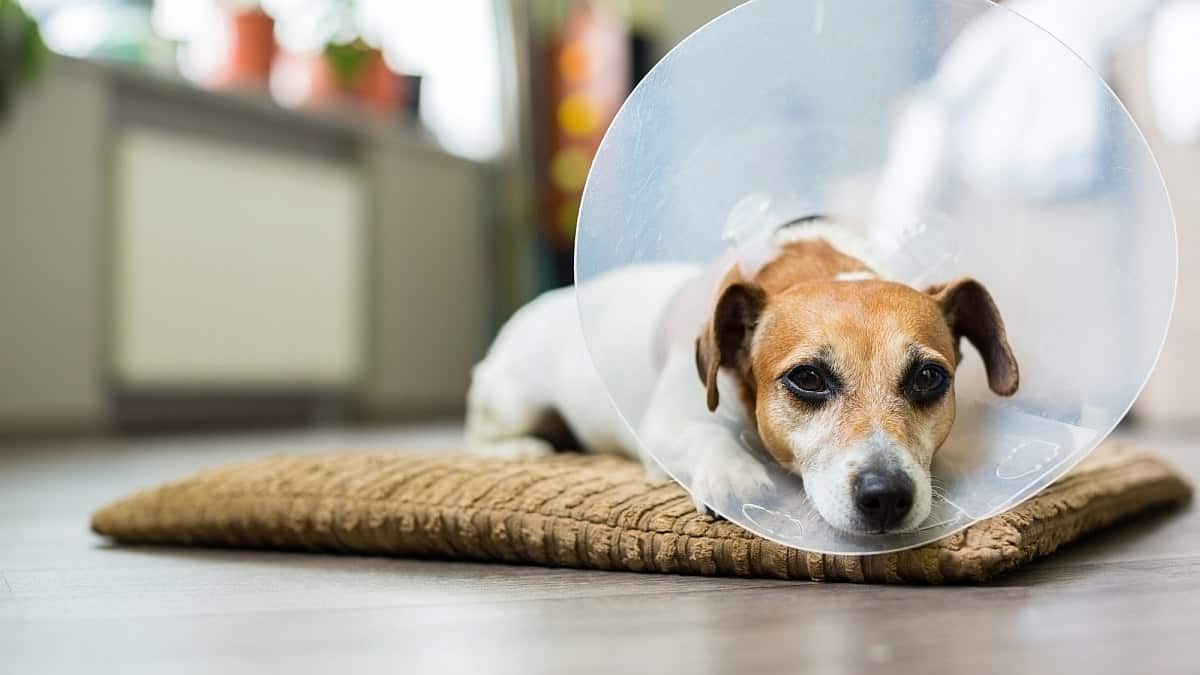






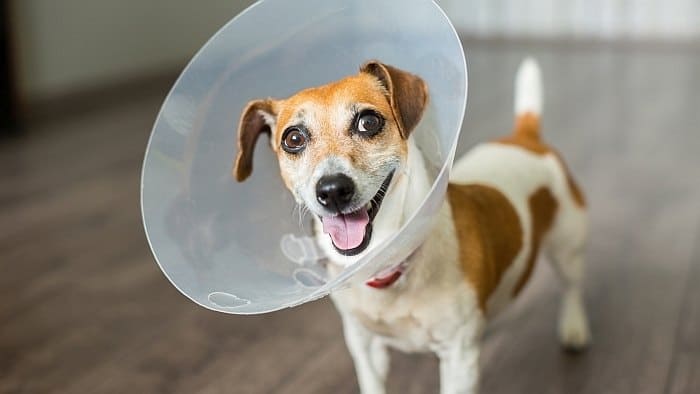



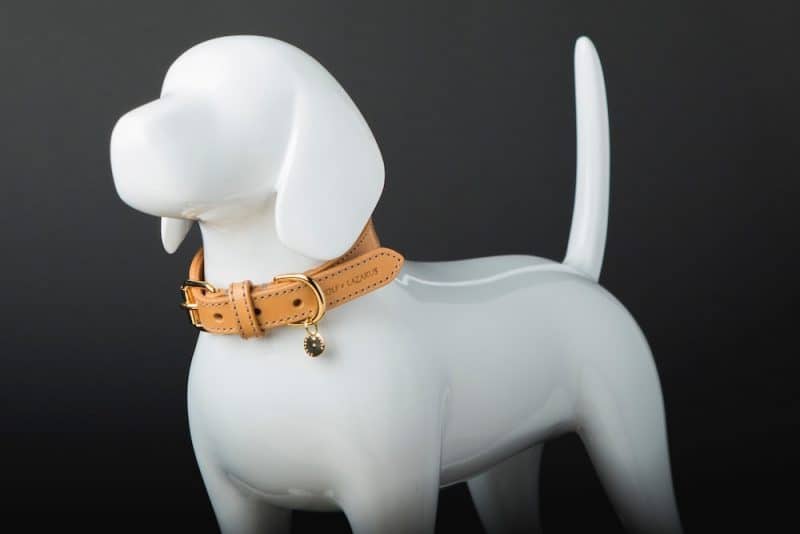

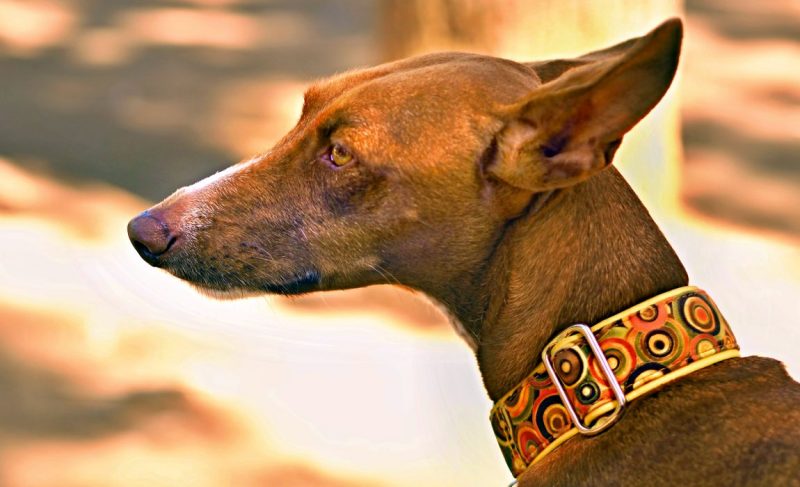

Leave a Comment